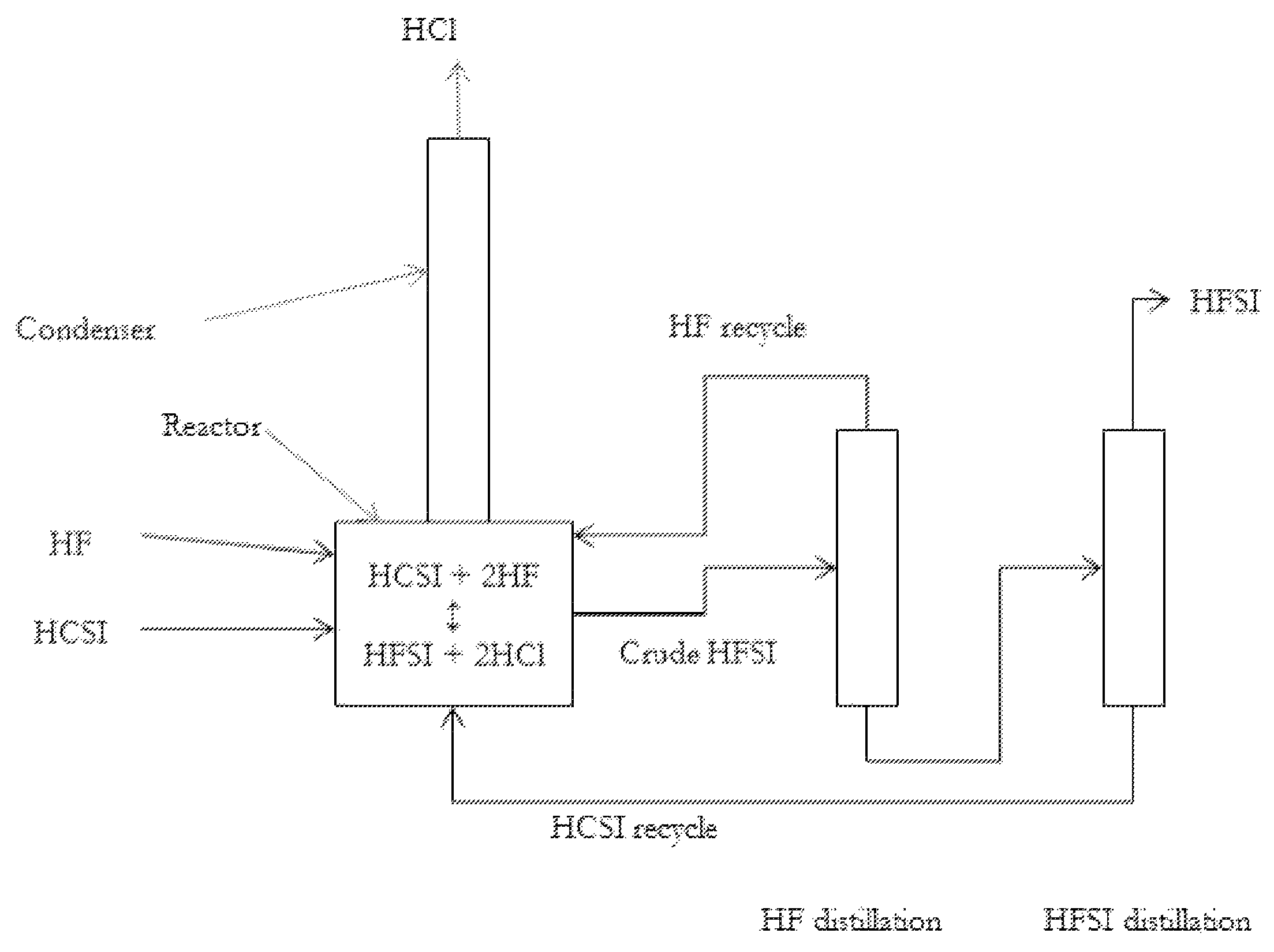Synthesis of hydrogen bis(fluorosulfonyl)imide
a technology of fluorosulfonyl and hydrogen bisulfonyl, which is applied in the direction of organic chemistry, nitrogen and non-metal compounds, chemistry apparatus and processes, etc., can solve the problem of unsatisfactory hf production method, and achieve high yield and high yield
- Summary
- Abstract
- Description
- Claims
- Application Information
AI Technical Summary
Benefits of technology
Problems solved by technology
Method used
Image
Examples
example 1
[0036]A 120 mL PFA reactor with a PFA coated thermocouple, a PTFE coated magnetic stir bar, and PTFE boiling stones was charged with 47.4 g (0.221 mol) HCSI. The reactor was connected to a condenser consisting of a vertical 60 mm long PTFE tube having an internal diameter of 9.5 mm. The outside of the condenser tube was jacketed with a vessel holding a mixture of dry ice and methanol. The top of the condenser was swept with dry argon, which carried gases from the top of the condenser to an alkaline scrubber before venting. An inlet port to the reactor provided means to feed gaseous HF into the system which would condense in the condenser and drip into the reactor. The reactor was immersed in a heated and stirred oil bath. A target addition of 8.86 g (0.443 mol) HF was required to convert the HCSI to HFSI. HF was added in increments. The first addition was 3.5 g (0.175 mol) HF, and the solution boiled at 36.5° C. and was refluxing. Ambient pressure was 82 kPa. No change in boiling po...
example 2
[0037]Using the same reactor system as described in Example 1, 51.768 g (0.242 mol) of HCSI was charged to the reactor. No bismuth material or PTFE boiling stones were added. The reactor was heated to 100° C., and HF was added portion wise while trying to maintain the reaction temperature near 100° C. The reactor temperature ranged between 61 and 110° C. between HF additions, and the mass of HF added was not recorded. After multiple small HF additions over the course of 4.5 hours, the temperature stabilized at 85° C. The reactor was cooled and began crystallization at 12.2° C. The condenser was heated to room temperature and the reactor reheated to about 115° C. with argon flowing through the reactor for about 30 minutes to remove excess HF from the liquid product. The contents were then cooled and a melting point of 18.6° C. was measured. The product weighed 42.798 g, which corresponds to 0.236 mol and a 98% as HFSI. As sample was taken and analyzed by ion chromatography, which ind...
example 3
[0038]Using the same reactor system as described in Example 1, 51.184 g (0.239 mol) of HCSI and 2.86 g (0.00907 mol) BiCl3 were charged to the reactor. The reactor was heated to 100° C., and HF was slowly added while trying to maintain the reaction temperature near 100° C. The reaction temperature ranged between 90 and 110° C. Over the course of 3.5 hours and after multiple small HF additions, the reaction temperature stabilized at 96° C. The condenser was allowed to heat to room temperature and the reactor was heated to 100° C. under flowing argon for 1.25 hours in order to remove excess HF. Then the reactor was cooled and a melting point of about 9.2° C. was measured. The product weighed 45.261 g, which corresponds to a 99% yield including conversion of BiCl3 to BiF3. A sample of liquid product was taken and analyzed by ion chromatography, which indicated nearly 100% FSI− and about 200 ppmw Cl− and 600 ppmw F−.
PUM
| Property | Measurement | Unit |
|---|---|---|
| Fraction | aaaaa | aaaaa |
| Fraction | aaaaa | aaaaa |
| Reaction temperature | aaaaa | aaaaa |
Abstract
Description
Claims
Application Information
 Login to View More
Login to View More - R&D
- Intellectual Property
- Life Sciences
- Materials
- Tech Scout
- Unparalleled Data Quality
- Higher Quality Content
- 60% Fewer Hallucinations
Browse by: Latest US Patents, China's latest patents, Technical Efficacy Thesaurus, Application Domain, Technology Topic, Popular Technical Reports.
© 2025 PatSnap. All rights reserved.Legal|Privacy policy|Modern Slavery Act Transparency Statement|Sitemap|About US| Contact US: help@patsnap.com



